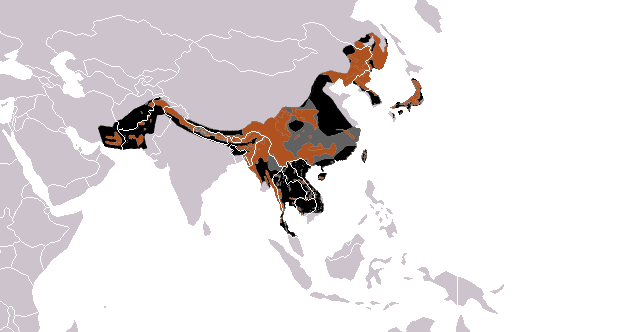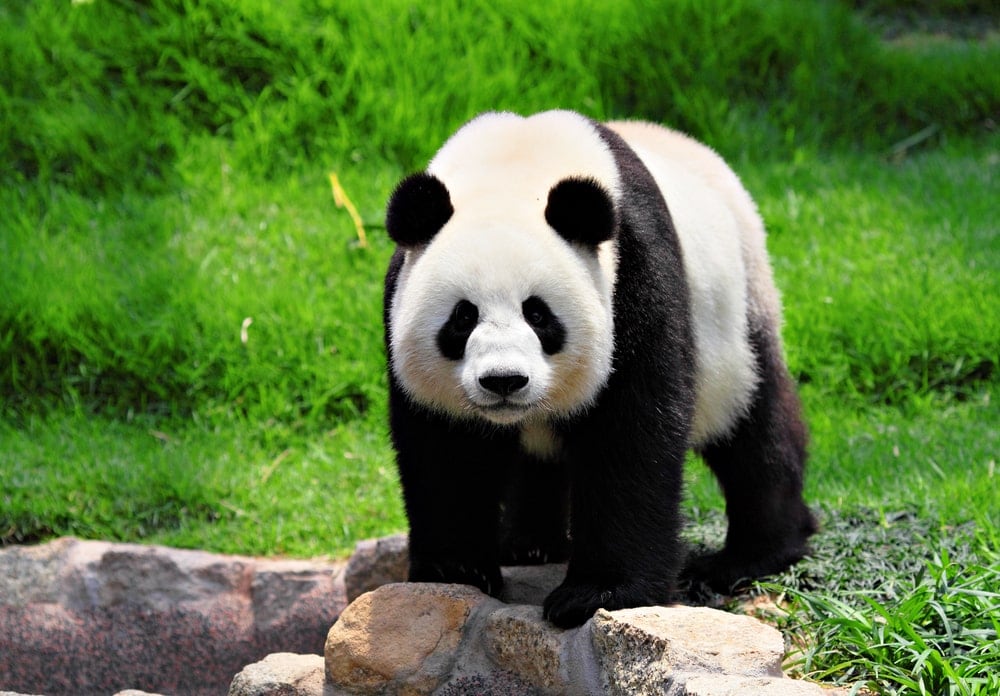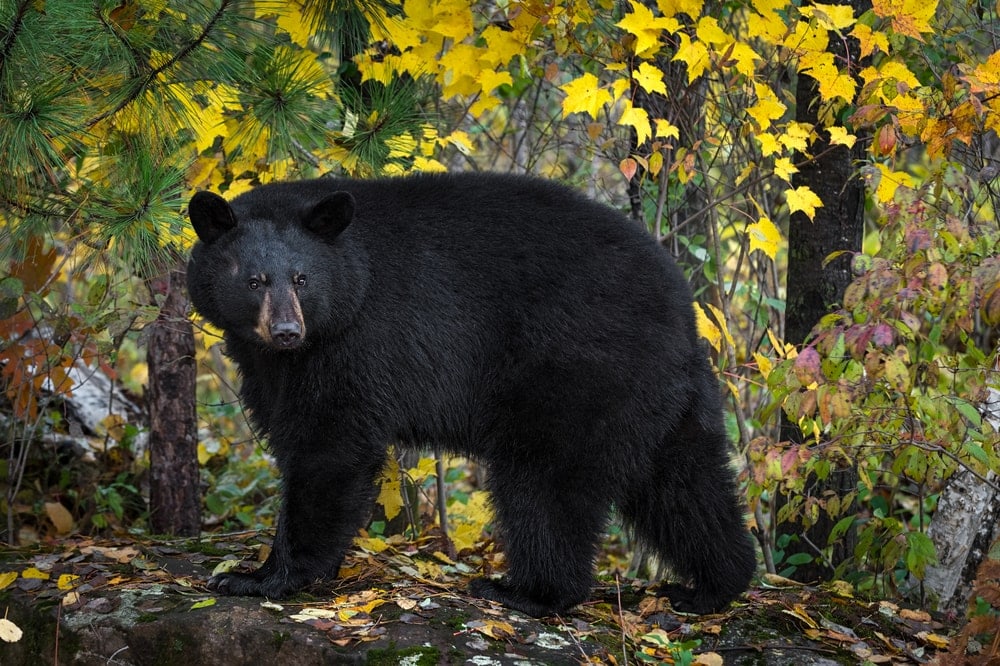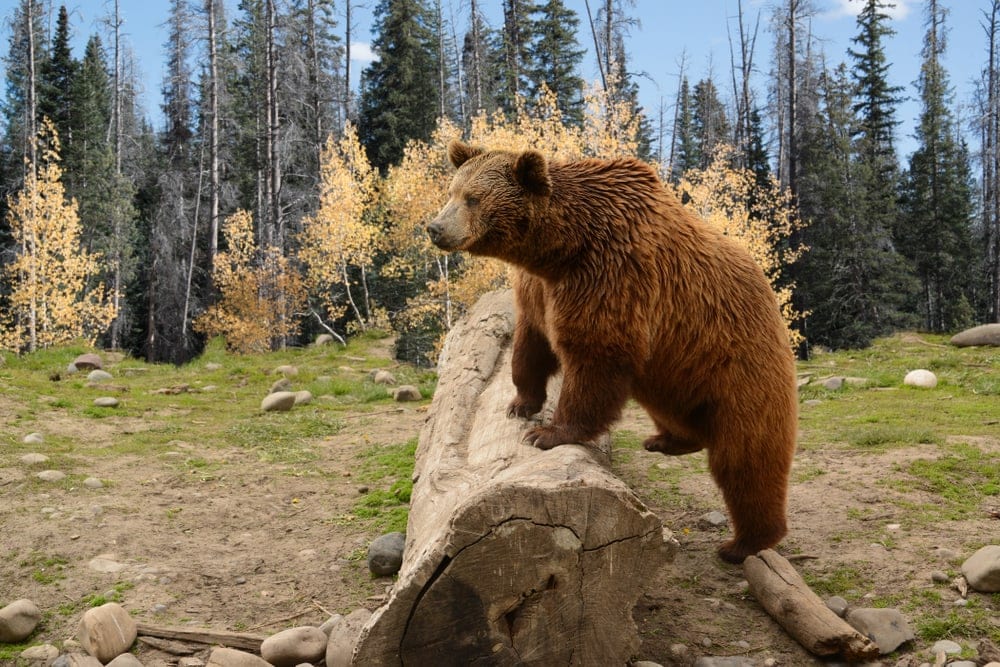Bears are an incredible demonstration of the might of nature. They are both respected and feared by anyone in their territory. Nowadays, you can find bears all over the world, spread throughout forests and tundras. The largest populations of them are in North and South America, Asia, and Europe.
Although there might have been many more, there are only eight species of bears that exist today. Out of these eight, six of the species are either endangered or vulnerable.
This article is your one-stop shop for all the information you need on bears. That includes their species, classification systems and conservation efforts. Admiring a species from afar isn’t always enough. Consider how you might support the effort to save all the endangered species of bear.
8 Species of Bears

The bear species have similar characteristics that allow them to remain in the same family. However, there are plenty of differences between each species and grouping that sets them apart.
For example, a bear’s weight can range from 60 to 1,600 lbs (27.2 to 725.7 kgs), depending on their age and species. When a bear stands, they reach anywhere from 4 to 8 feet (1.2 to 2.4 m) tall.
All types of bears are omnivorous, meaning they eat a mixture of meat and any type of plant. They scavenge and hunt for their food but only kill what they need. Their body stores fat and protein mean they don’t have to kill other mammals very often.
A great example of this is the American Black Bear. They can go for about 100 days without eating, drinking, defecating, or even urinating when they are in hibernation.
Even outside of hibernation, they can conserve their energy to live for half of that time without significant discomfort. Bears live off the layer of fat they build up during times of plenty, such as summer through early fall.
Are you ready to learn more about the eight species of bear that have successfully survived through the ages? Read on to learn about each species and some of the subspecies grouped under them.
1. Brown Bear (Ursus arctos)

In North America, the Brown Bear or Grizzly Bear is likely the most well-known species. These bears have the most expansive range around the world. They share the number with the American Black Bear, each with sixteen.
The Brown Bear lives throughout the Northern parts of North America and most of the Western half of Canada. They’re well-known throughout all of Alaska as well. You have likely seen a picture of a bear fishing for salmon in the Alaskan wilderness, with the beautiful fish seeming to jump into their mouths.
(geographic distribution of brown bear)
These bears spread throughout Europe, some of the Middle East, Asia, and most of Russia. They’re very adaptable. Their habitat includes the desert, wetlands, grassland, forest, and shrubland.
Their diet is also quite varied as omnivores. They eat all kinds of grasses, roots, herbs, berries, nuts, insects, fish, and mammals. Essentially, they will find food anywhere if they can.
Brown bears are typically quite large. Since they have so many subspecies, it’s difficult to generalize their size. They can range from 176 to 1,213 lbs (79.8 to 550.2 kgs).
The subspecies of the Brown Bear include:
- Tibetan Blue Bear (Ursus arctos pruinosus)
- Marsican Brown Bear (Ursus arctos arctos)
- California Grizzly Bear (Ursus arctos californicus)
- Grizzly bear (Ursus arctos horribilis)
- Alaskan Grizzly Bear (Ursus arctos alascensis)
- Kamchatka Brown Bear (Ursus arctos beringianus)
- East Siberian Brown Bear (Ursus arctos collaris)
- Atlas Bear (Ursus arctos crowtheri)
- Dall Island Brown Bear (Ursus arctos dalli)
- Alaska Peninsula Brown Bear (Ursus arctos gyas)
- Himalayan Brown Bear (Ursus arctos isabellinus)
- Ussuri Brown Bear (Ursus arctos lasiotus)
- Kodiak Bear (Ursus arctos middendorfii)
- Stickeen Brown Bear (Ursus arctos stikeenensis)
- Syrian Brown Bear (Ursus arctos syriacus)
- ABC Islands Bear (Ursus arctos sitkensis)
Most of the Brown Bears worldwide are classed as Least Concern when it comes to their conservation. Some species are poached more frequently, particularly in Asia. Most of the Brown Bear populations have 110,000 members or more in them.
2. Asiatic Black Bear (Ursus thibetanus)

The Asiatic Black Bear is another member of the Ursus family with seven subspecies classified beneath them. They all live within Asia, ranging from the North of India, Indonesia, Japan, and China.
A sad change for these bears has taken place over the last 50 years. Their range has changed and become much smaller. Their populations have become small pods where it’s difficult for them to compete with other communities of bears. That acts as a population control on already vulnerable species.

Asian black bear range
(brown – extant, black – extinct, dark grey – presence uncertain)
On the map, the black color is where all the past populations have gone extinct. The brown pools are where you can currently find them. The dark grey color represents where researchers and trackers are uncertain.
Many Asian Black Bear species need much more protection if they survive in their natural habitat. They make their home in forested areas, inland wetlands, shrubland and grassland. They eat ungulates and livestock, which is part of what gets them killed. The berries and nuts they collect are harmless but less frequent.
These bears are much smaller than American Grizzly bears. They range from 143 to 331 lbs (64.9 to 150.1 kgs) in size.
The subspecies of the Asian Black Bear include:
- Formosan Black Bear (Ursus thibetanus formosanus)
- Japanese Black Bear (Ursus thibetanus japonicus)
- Indochinese Black Bear (Ursus thibetanus mupinensis)
- Balochistan Black Bear (Ursus thibetanus gedrosianus)
- Himalayan Black Bear (Ursus thibetanus laniger)
- Ussuri Black Bear (Ursus thibetanus ussuricus)
- Tibetan Black Bear (Ursus thibetanus thibetanus)
The seven subspecies of Asian Black Bear are vulnerable species for the most part. That means their populations consist of 50,000 bears or less.
3. Sloth Bear (Melursus ursinus)

The Sloth Bear is a fascinating creature. These bears look like they’re a cross between an anteater and a grumpy old man. Similar to the anteater, they rely on insects as the staple of their diet.
Their palate and lower lip have an elongated and narrow shape to help them catch insects like ants, termites and bees.
Sloth bears are very territorial and will attack a human if they feel threatened. If a human trespasses into their habitat, they will go after them. It’s partially for this reason that they’re so hunted and feared.
Sloth bears are a vulnerable species. People hunt them if they get too close to human populations or try to attack a human. Habitat loss is another part of their population decrease. These bears are native to India. As human populations exponentially expand, these bears become closer to endangerment.

One of the cutest aspects of a sloth bear isn’t their hairy ears or their shaggy fur. Their cubs develop slower than other bear species. Instead, the cubs hitch a ride on their mother’s back until they are strong enough to hunt independently.
4. Giant panda Bear (Ailuropoda melanoleuca)

Giant Panda Bears were one of those species discussed in the scientific community for years. For decades, no one knew how to classify them, especially since they thought these bears were close to the Red Panda.
Giant Pandas are one of the only bears whose diet is 99% made up of plant material. Almost the only thing they eat is bamboo. It’s because of this minimal diet that they were endangered for many years. Only recently has their status changed to vulnerable because of global conservation efforts.
There have been extensive deforestation projects in China that have wiped out the bamboo populations. That loss of food decreased their population significantly.
Pandas also have a minimal range. They live in the mountain ranges throughout central China. Almost as many live in captivity around the world as the wild ones left in China.

Ready for an interesting fact about pandas? The Giant Panda doesn’t hibernate. They’re the only bear that doesn’t have an annual cycle that includes hibernation.
5. Spectacled Bear (Tremarctos ornatus)

The Spectacled Bear is the only species in its family anymore. They are the last species of short-faced bear that remain. These intelligent-looking creatures are vulnerable, with many people working to save them as the last of this kind of species.
The Spectacled Bear has an interesting diet. It eats a mix of plant and animal matter. They eat bromeliads and palm trees for the most part. They snack on cattle and other mammals whenever the greater need for protein arises.
Only 5% of their diet is meat, but that is enough to make them the largest carnivore in the region and become hunted should they prey on livestock. They don’t like to compete with each other. They tend to isolate themselves instead. In areas of abundance, they will live in small groups.

These bears live in the Andes Mountains in South America. They make their habitat in almost any biosphere of these mountains. That includes shrubland, grassland, and the forest. They tend to spend most of their time in trees to stay safe.
6. Malayan Sun Bear (Helarctos malayanus)

The Malayan Sun Bear is the smallest living bear species. They only weigh between 60 to 110 lbs (27 to 50 kgs). These bears were revered and protected in their native land of Indonesia and Malaysia for a while.
At one point, natives thought they had medicinal properties, and people hunted them for the medicine they could provide. That has proven to be false, but many bears died before science proved it.
The Sun Bear is also frequently called the Honey Bear since they enjoy the sweet treat so much. Their diet doesn’t only consist of honey, though. They also eat small mammals, fruit, palm tree tips and birds.
There are two subspecies of sun bear. They developed separately due to the ocean cutting the populations off between Indonesian islands. These subspecies include:
- Bornean Sun Bear (Helarctos malayanus euryspilus)
- Malayan Sun Bear (Helarctos malayanus malayanus)

(brown – extant, black – former, dark grey – presence uncertain)
Both of these bears are vulnerable. They have 50,000 members in their population or less. Both of their populations are also rapidly decreasing due to hunting and habitat loss.
7. Polar Bear (Ursus maritimus)

Although you might not have been familiar with all these bears, everyone has heard of the Polar Bear. Polar Bears have a unique habitat and way of living. They live in the Arctic and feed primarily on any type of seals since there is very little vegetation in the ice tundra.
Polar Bears are often the largest bears. Their weight can reach up to 1,600 lbs (726 kgs). That is getting less common since each year, it gets more challenging for them to find food.

Polar bears don’t only live in the Arctic, though. They’re quite common throughout Greenland and Northern Canada. They adapted to marine and oceanic habitats. They can also make their home in shrubland, grassland, and forests.
Although Polar Bears eat seals more than anything, they also feed on mammals as large as Beluga Whales and Walruses. They eat fish, birds and will even feed on kelp. Their population is vulnerable, with only 23,000 left of the species.
8. North American Black Bear (Ursus americanus)

Finally, there is the North American Black Bear. There are sixteen subspecies of this bear, all of them living within North America. You cannot find them living naturally anywhere else in the world even though there are so many species.
The Black Bear is one of the most versatile types of bears. They make their home in almost any climate and biosphere in North America. They’re highly adaptable to temperature changes and environments. This adaptability is what helps them remain the Least Concern animal. Even with deforestation and climate change, they can move into another area without much fuss.

It’s the North American Black Bear species that you will often hear about when you gear up to go for a hike in the woods in the U.S. and Canada.
The subspecies of Black Bear include:
- Kermode Bear (Ursus americanus kermodei)
- Olympic Black Bear (Ursus americanus altifrontalis)
- New Mexico Black Bear (Ursus americanus amblyceps)
- California Black Bear (Ursus americanus californiensis)
- Eastern Black Bear (Ursus americanus americanus)
- Cinnamon Bear (Ursus americanus cinnamonum)
- Haida Gwaii Black Bear (Ursus americanus carlottae)
- East Mexican Black Bear (Ursus americanus eremicus)
- Glacier Bear (Ursus americanus emmonsii)
- Newfoundland Black Bear (Ursus americanus hamiltoni)
- Florida Black Bear (Ursus americanus floridanus)
- Vancouver Island Black Bear (Ursus americanus vancouveri)
- Kenai Black Bear (Ursus americanus perniger)
- Louisiana Black Bear (Ursus americanus luteolus)
- West Mexican Black Bear (Ursus americanus machetes)
- Dall Island Black Bear (Ursus americanus pugnax)
You may also like: Discover the Two Different Types of Bears in Japan, Their Characteristics and Their Traits: Complete with Images, Facts, & More!
How to Classify All the Types of Bears

Share This Image On Your Site
<a href="https://outforia.com/types-of-bears/"><img style="width:100%;" src="https://outforia.com/wp-content/uploads/2021/06/Types-of-bears-infographic.png"></a><br> Bear Species Infographic by <a href="https://outforia.com">Outforia</a>All bears belong to the family Ursidae. Their name in English comes from an Old English word. The word “bera” meant brown. It described the large populations of brown bears spread throughout Europe and North America.
All the bears that you will find wandering the globe today fit into eight main species. These eight species of bear include:
- Brown Bears (Ursus arctos)
- Asiatic Black Bears (Ursus thibetanus)
- Giant Pandas (Ailuropoda melanoleuca)
- North American Black Bears (Ursus americanus)
- Polar Bears (Ursus maritimus)
- Spectacled Bears (Tremarctos ornatus)
- Sun Bears (Helarctos malayanus)
- Sloth Bears (Melursus ursinus)
Under the Ursidae family, three subfamilies contain all the species listed above. They only have one species except for the Ursinae, which contains three genera and six species.
The first subfamily is the Ailuropodinae. It only contains one species, the Panda Bear. The next is the Tremarctinae, which contains the Spectacled Bear.
Finally, Ursinae has three genera, the Helarctos, the Melursus and the Ursus. The Helarctos has one species, the sun bear. The Melursus includes the sloth bear. The Ursus is the largest bear genus and includes four species. Those are the American Black Bear, Asian Black Bear, Brown Bear, and the Polar Bear.
Some of these species have been moved around relatively recently, including the Panda Bear. The main reason for the distinct separation of the species found in each subfamily is geographic location. The types of bears are spread all over the world and have evolved distinctly from their origin species.
An excellent example of this is the separation between the Spectacled bear and the Giant Panda. Although you can see that they are both bears, their bone structure and even facial structure are quite different. The Spectacled Bear lives in the Andes Mountains in South America, separated from the Panda in China.
Then you have the Ursus bears, almost all of which are throughout North America and Europe. Researchers consider these bears to be more closely related and would have spread out and diversified much later on in the grand scheme of time. Ancient land bridges between the Arctic, North America, and Europe were the links that allowed the bears to move around with time.
Fake Bears
“Fake bears” isn’t their official name. There are quite a few species that people tend to think are bears that aren’t even closely related to a bear.
Some of these species were bears for many years. The more recent development of DNA testing has cleared up a lot of the speculation regarding these species. As scientists tested their DNA, they put them into different groups of animals.

Some of these species include the Koala Bear and the adorable Red Panda. Even the Koala Bear’s name is deceiving. The Koala is a marsupial, related more closely to the kangaroo than the bear.
The Asian Bearcat is another example that got reclassified. They are a viverrid, a group of animals related more to genets and civets than a bear.
Even with DNA testing, the Red Panda is still a bit of an anomaly. Researchers have reclassified them under the superfamily belonging to raccoons and weasels. That has been tentative and is still under discussion. As of yet, they still have their own family, separate from any other animal.

Finally, you have the teddy bear, which has stumped researchers for millennia. There is so much confusion surrounding this inanimate bear. So much so that they have yet to classify it in any group of the Animal Kingdom.
You may also like: Learn More About the Bears in Arizona and What to do When You Encounter One
Bear Habitat and Conservation

Bears are mammals of incredible strength and size. Yet, their fur and faces make them adorable teddy bears in modern culture. Even this interest hasn’t been enough to save most of the species that used to exist.
Fossil records suggest that at one point, there were hundreds of bear species across the globe. They used to live on all continents, except Antarctica and Australia. Now, the eight species that remain edge closer to extinction each year.
The biggest threat to all types of bears is habitat loss. As logging and the growth of agriculture eats up more land, the bears get pushed out. It’s similar to the way that a plant in a pot can only grow so large. The populations of bears will only expand so far before they don’t have any more resources to split among them.
Since bears are omnivorous and can be pretty large, there is a certain level of fear surrounding them. Those bears that come close to human development get killed out of concern for human safety.
As time goes on and people become more aware of bears’ plight, we make new attempts to save them. For example, instead of being killed, people can rehome bears. That involves capturing them and moving them from their home near human developments. They get relocated to a safer space.
In Asia, the most significant threat for bears is poachers. The illegal wildlife trade in China prizes bear bile. Bear bile comes from the gall bladder, and you can only extract it if you kill the bear. Other parts, like their paws and skin, are also quite valuable.
Finally, the biggest threat to polar bears is climate change. Their home environment is melting away as the world heats up. They depend on sea ice and seals for their meals.
Because of this, they sometimes have to go for months without eating while they wait for the ice to solidify. That throws off their mating and gestation periods. It results in small populations of polar bears compared to previous ages.
You May Also Like: Check Out What Kinds of Bears Live in Colorado complete with Facts, Photos, Guide, and more!
Interesting Facts about Bears
1|‘Grolar’ and ‘Pizzly’ Bears are becoming more prominent.
Animals are inherently able to adapt to changes in their environment. As some species go extinct, new mixes emerge that can take on their changing habitat.
We can see this happening now as the climate warms and more of the Polar Bears environment gets destroyed. More Brown Bears and Polar Bears end up wandering into each other’s territory. While this sometimes results in fights, it can also result in breeding.
In 2006, scientists confirmed the existence of a Grolar or Pizzly bear. Their hybridization had never occurred in the wild previously. The mixing of these genes might help make Polar Bears more adaptable as the climate changes.
2|Pandas have an extra bone for eating.
As we discussed above, Pandas almost exclusively eat bamboo. Over time, their bodies have adapted to make it easier for them to chew on these highly fibrous stems and leaves. They developed an elongated bone on their wrist that functions almost like a thumb. Although it isn’t a true thumb, the adaptation does make it easier for them to stabilize their bamboo feast.
Want some more interesting facts about Pandas and bamboo? They will spend up to 12 hours of a 24 hour period eating to get all the nutrition they need in a day. They can eat between 20 to 40 lbs (9.1 to 18.1 kgs) each day!
3|Bears have always had a sweet tooth.
We all know that bears love a good sweet treat. They enjoy snacking on berries and will be happy to feast on a beehive. That isn’t a recent adaptation to help them advance their fat layer for hibernation.
Bear fossils found in Canada date back more than 3.5 million years ago. These bears have tooth decay. That suggests that they liked eating large amounts of sweet berries just like their modern counterparts.
4|Polar Bears are marine mammals.
Polar Bears have particular adaptations that make them just marine animals as much as they’re land animals. They even fall under the Marine Mammal Protection Act.
What makes them so adapted to marine habitats? They have partially webbed forepaws. That allows them to swim quickly through the water.
They also have an extra layer of blubber and a thicker coat. These adaptations provide them with more buoyancy in the water regardless of their size. It also protects them from freezing temperatures.
The last significant adaptation that sets them apart from other bears is that their nostrils can close when they’re underwater. It helps them hold their breath for longer.
5|Bears are very intelligent.
The mind of a bear gets underestimated. Scientists have tested American Black Bears and their ability to count. They found that a bear’s ability to distinguish between small and large numbers of dots was as successful as a monkey’s!
What’s more, bears are good planners. They take their time and think things through, even using rocks and other objects as tools.
Bears can also communicate with each other. It might all sound like grunts and hacks to you. To another bear, these each have a slightly different meaning. There are 11 different sounds bears use to communicate, along with a wide range of body language.
6|Only one bear species lives in the Southern Hemisphere.
There used to be more bear species that lived throughout the Southern Hemisphere. Now, there is only the Spectacled Bear that makes its home in South America. There are no bears that currently live on the African or Australian continent.
7|We haven’t humanized them without reason.
Many people love bears. It’s part of the reason that teddy bears have been so popular for many years. There is a reason for this as well.
Bears feel emotions with intensity. Scientists have found that bears are capable of feeling happy and grief if someone they love dies. Cubs are the most distinct example of this. If their mothers leave, they will cry and moan until their return. That continues for weeks if the mothers die.
8|Some Asiatic Bears build nests.
Many bears are excellent climbers. The best of them all is the Asiatic Bears. These bears don’t only climb if they are hunting or trying to escape from a predator. They build nests in the tree, often more than one. They scatter them throughout their habitat. They use these tree nests for eating, sleeping and hiding.
You don’t have to worry about a cub falling out of a tree, though. They come back to the ground when they are ready to give birth and can’t climb as well when pregnant.










